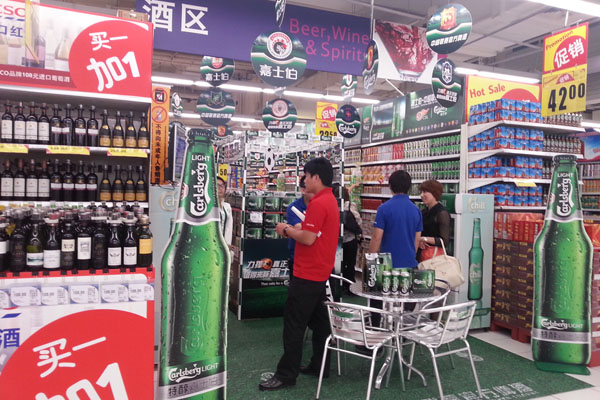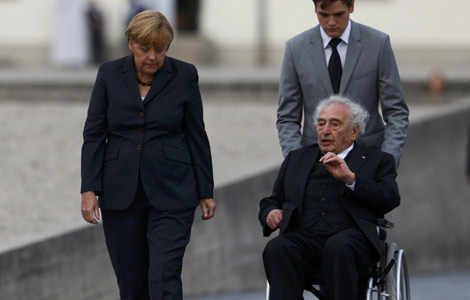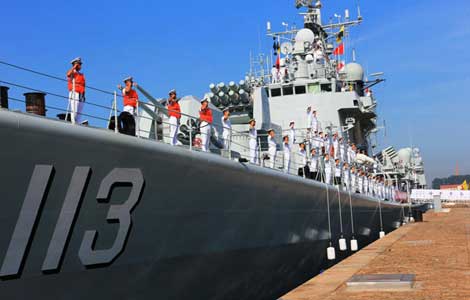
China targeted for wide sales drive by Carlsberg with a close eye on market
When Chinese people drink beer, very few of them drink in liters. They prefer to order it in small volumes. In a typical scenario: When four Chinese people go out to dine they buy four bottles of beer.
There is a trend of downsizing beer bottles among local breweries, said Stephen Maher, chief executive officer of Carlsberg China, therefore downsizing beer consumption and slowing down the growth of the industry.
 |
|
Carlsberg's products available in large packs at retailers in China. Provided to China Daily |
Local beer breweries that want to raise their profitability but are resistant to increase the price are making their bottles smaller. In order to avoid price growth, they have been launching a more premium beer but downsizing the bottle, according to the Australian executive.
As a result the buyer tries to drink a better quality beer but less of it, said Maher, sitting in a conference room wearing a black T-shirt sporting the logo of one of his brands, Tuborg, which targets young music fans.
"Therefore by downsizing bottles, it's downsizing consumption," he said. "That's really driving the slowdown in the growth."
Carlsberg has brought in products that are more premium that enable them to invest back in the business. If people want to buy a can, they buy a bigger can of 500 ml, said Maher.
"If we can trade the consumers up to a 330 to a 500ml tin, we basically increase the consumption by almost 50 percent," said Maher, who has worked for Colgate-Palmolive Co and Procter & Gamble Co in emerging and developed markets prior to taking the position at Carlsberg in 2010.
Last year, Carlsberg's beer volumes in China grew 4 percent, largely driven by the strong performance of their international brands and the expanded distribution of both Carlsberg and Tuborg lagers.
Tuborg, is positioned in China as an international brand with a Chinese taste. It is lighter and about half the alcohol strength than that in Europe. Launched last April, Maher said it took them two years to get this product right for the China market. It sold rapidly in the country. In the first three months of this year, the company has already outsold the entire volume of last year.
By the end of this year, Tuborg will grow four times that of a year ago.The international band Carlsberg will grow close to 20 percent by the end of this year, because it's a much bigger business.
Secret of success
In the beer business in China, if you want to get it right, you have to get the Chinese dining right, understand it. That is the secret of success in the Chinese market according to the CEO of the Danish brewery.
Unlike very many developed markets such as Europe and America where it is common to drink at home with friends, in China most Chinese people wouldn't invite their friends home.
"As people move to cities, with their income increasing, they go out dining more — and that's the occasion most Chinese like to have a beer," he said.
Of Carlsberg's major brands, about 40 percent are sold during Chinese meals, 30 percent at convenience stores and mini markets and fewer than 5 percent of sales are from big foreign-owned supermarkets such as Carrefour SA and Wal-Mart Stores Inc, he said.
The different consumption behavior has also affected Carlsberg's marketing strategies. "In a dining environment, it's more about how we make beer relevant for that type of occasion, with big glasses or other material," said Maher. While "in the supermarket, it's more about how to drive consumption, so we may have six packs or the 500ml in 3 packs", he said.
Since 2002, the Danish brewery has consolidated its presence in West China and has continually expanded. In March, Carlsberg offered to buy a stake in Chongqing Brewery Co, targeting potentially up to 60 percent of the shares but so far gaining 30 percent.
Premium Level
Carlsberg considers West China to be a sleeping giant, much more profitable than East China, where competition is fierce and costs are higher, said the CEO.
In addition brands in western regions are old and the organization could do with some Western managers, he said. Just from local consumption, Carlsberg's productivity has improved 25 percent since 2010.
Carlsberg now has 7 percent of the country's beer market and is expected to rival other industry leaders through the acquisition of second-tier local breweries.
The Chinese beer industry is consolidating at a rapid pace and is dominated by three domestic breweries: China Resources Snow Brewery, Tsingtao Brewery and Yanjing Brewery, as well as three foreign brands — Anheuser-Busch InBev, SABMiller Plc and Carlsberg.
Anheuser-Busch InBev has controlled local brands including Harbin, Zhujiang and Sedrin. Tsingtao has 60 breweries in 19 locations. With 80 breweries and a 21 percent market share, the largest beer manufacturer by production volume is China Resources Snow Breweries, which is a joint venture between China Resources Enterprises Ltd and the world's second-largest brewery SABMiller. Yanjing Brewery is focused on a local strategy and has a 12 percent market share.
Unlike other major beer breweries, Carlsberg pays attention to nurturing local brands. "We believe that people in Xinjiang will want to drink national brands such as Carlsberg and Tuborg, but they are also going to drink a local beer," Maher said.
Local brands and national brands are not in conflict, he added, because the same drinker may like different things on different occasions.
For example, if someone goes to a KTV, they will probably want to drink a more premium, a more famous brand such as Tuborg or Carlsberg. But when they go for a meal, or they go to the night markets, they probably want Wusu, a local brand, he said.
"One key pillar to driving business growth is to understand the consumer at the time they drink beer and find out how we can create more occasions that are relevant to them to drink beer," he said.
"Our business model is to take strong, powerful brands, make them all profitable, improve the quality, improve the experience and encourage them to move up to a more premium level," he added.
Vision
Maher is confident about the market potential in the country, where opportunities are created by the relatively low drinking of beer in the country at an annual volume of about 33 liters per head, low compared with that in Europe, in America and in Australia.
The government is continuously driving urbanization that leads to increasing city populations and the higher incomes will propel the consumption, he said.
With a portfolio of more than 20 brands sold in China, including Carlsberg, Tuborg, and Kronenbourg 1664, the CEO has vowed to make the company top of the industry in the country in the next decade, producing currently under 30 million hectoliters but between 100 and 200 in 10 years. A hectoliter is 100 liters. As the world's largest beer market, China has maintained rapid growth in drinking the beverage.
The brewery is expected to launch a couple of new products and continue to drive the local brands, as well as to expand their international brands Tuborg and Carlsberg, Maher said.
If Carlsberg China is able to achieve its growth ambitions through Carlsberg and Tuborg, they will have the potential to become the No 3 and No 4 global brands in the beer industry.
For Carlsberg internationally, China ranks second in the world in terms of volume. In three years, it is expected to be the biggest.
"China plays a significant role for Carlsberg because it enhances its global reputation," said Maher. "It's going to be biggest volume growth, biggest profit growth in the future."








